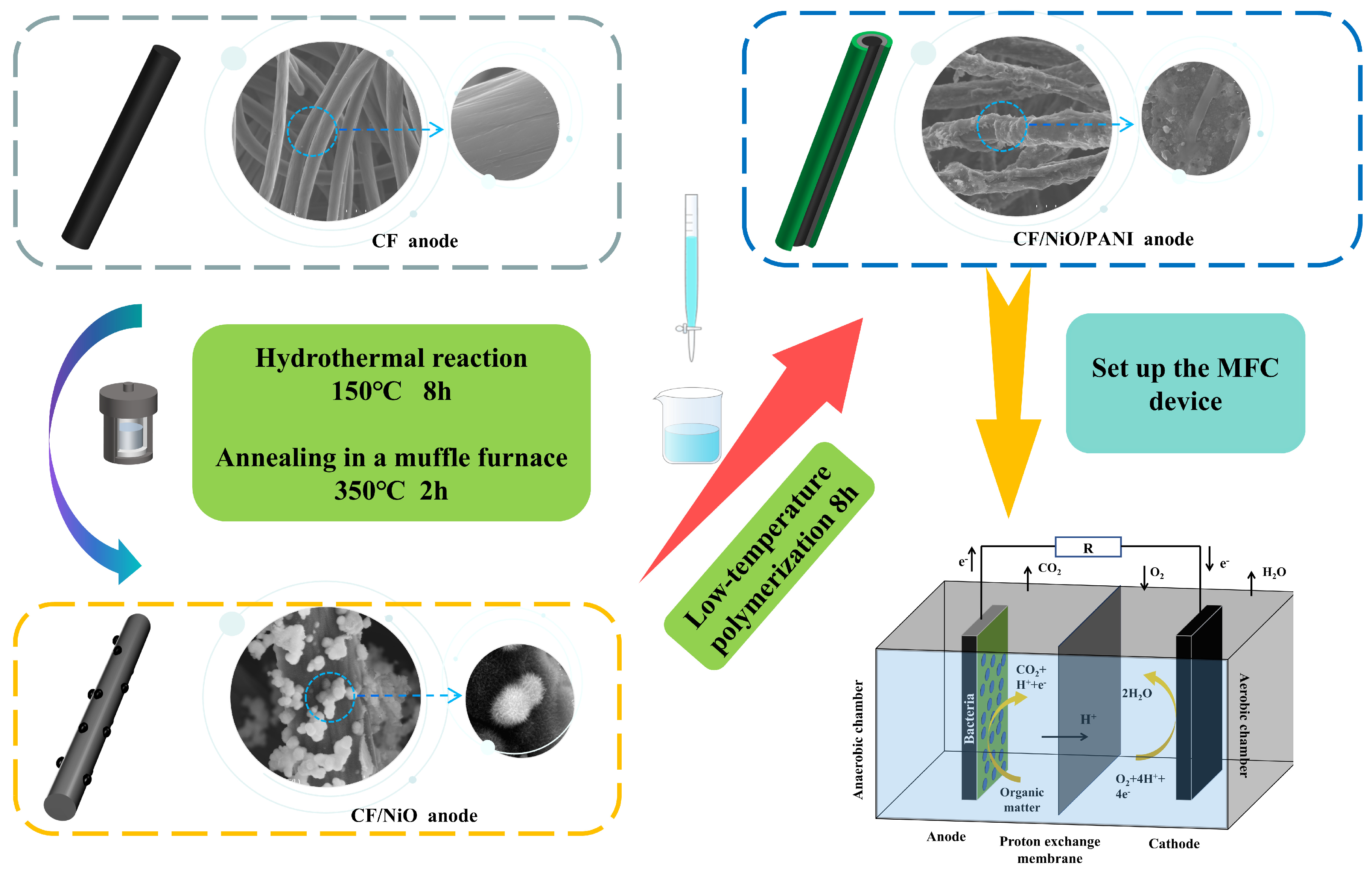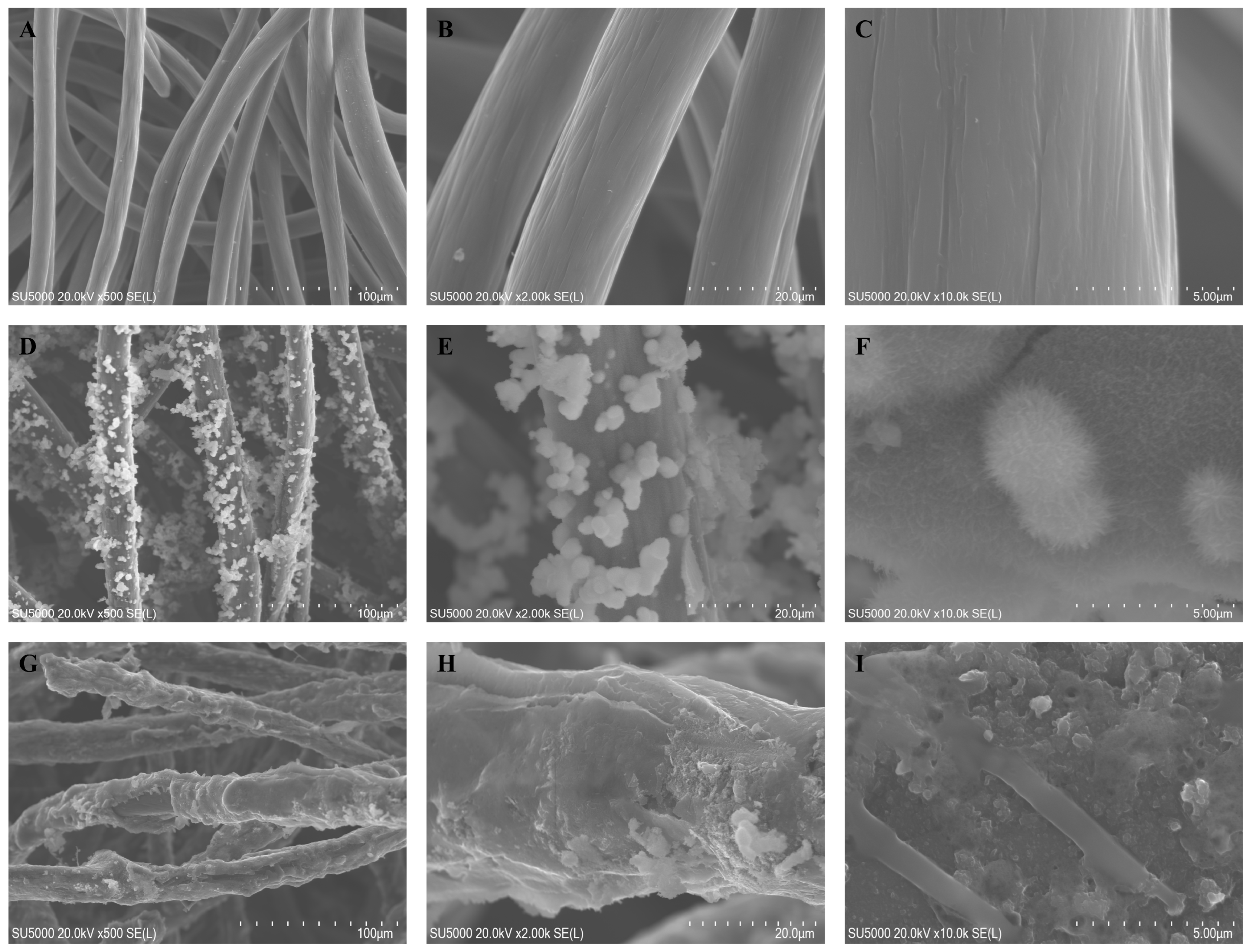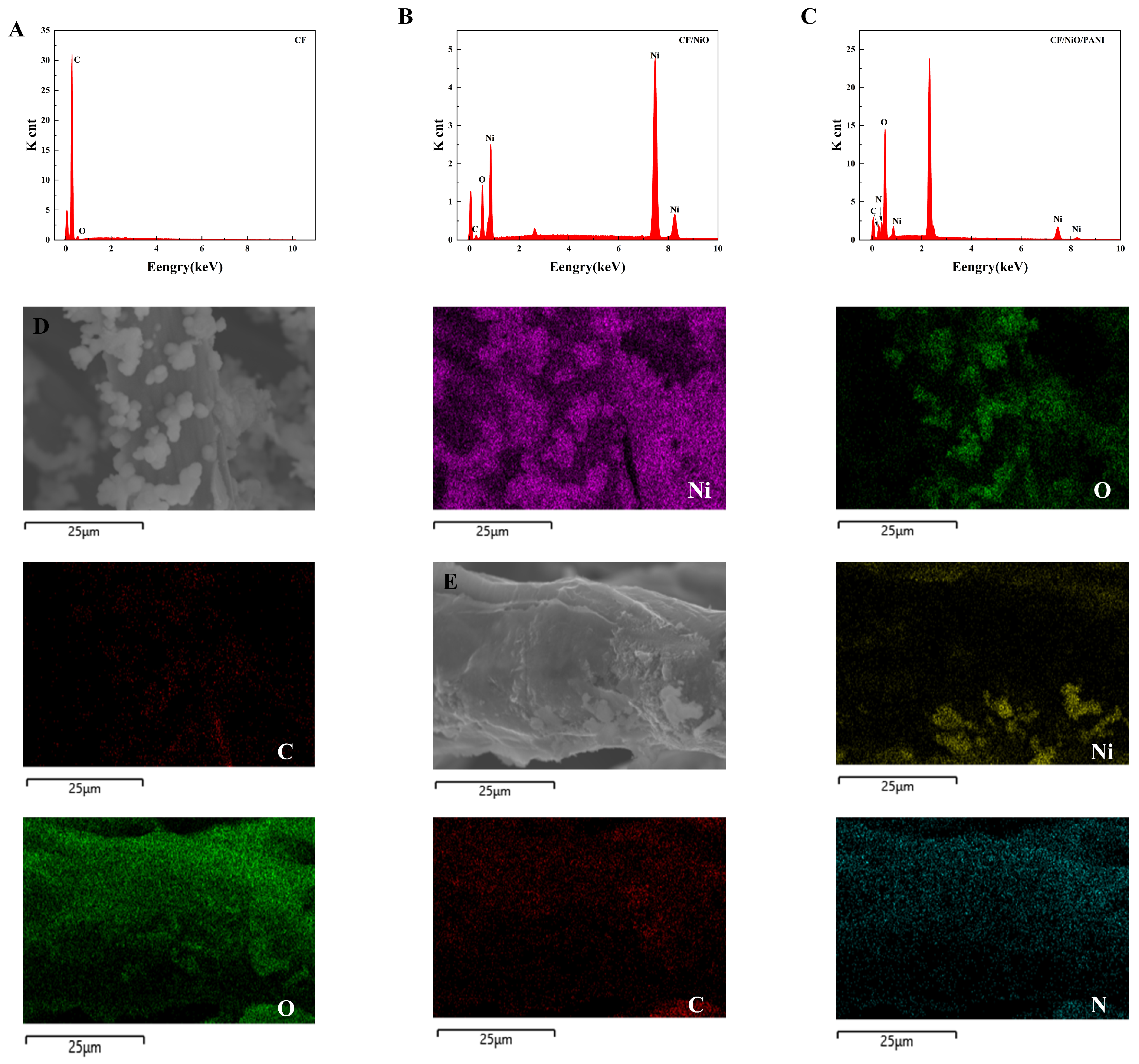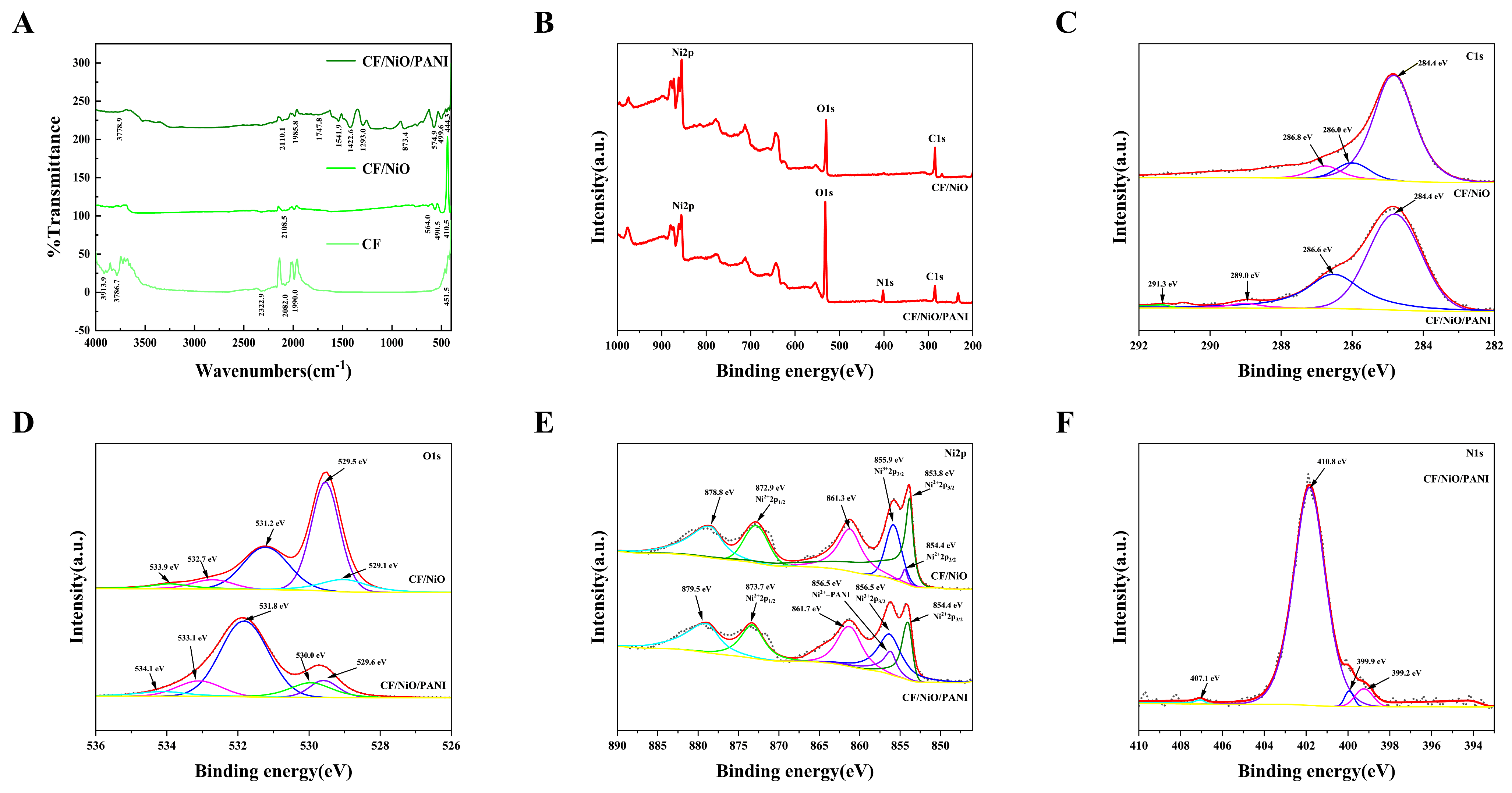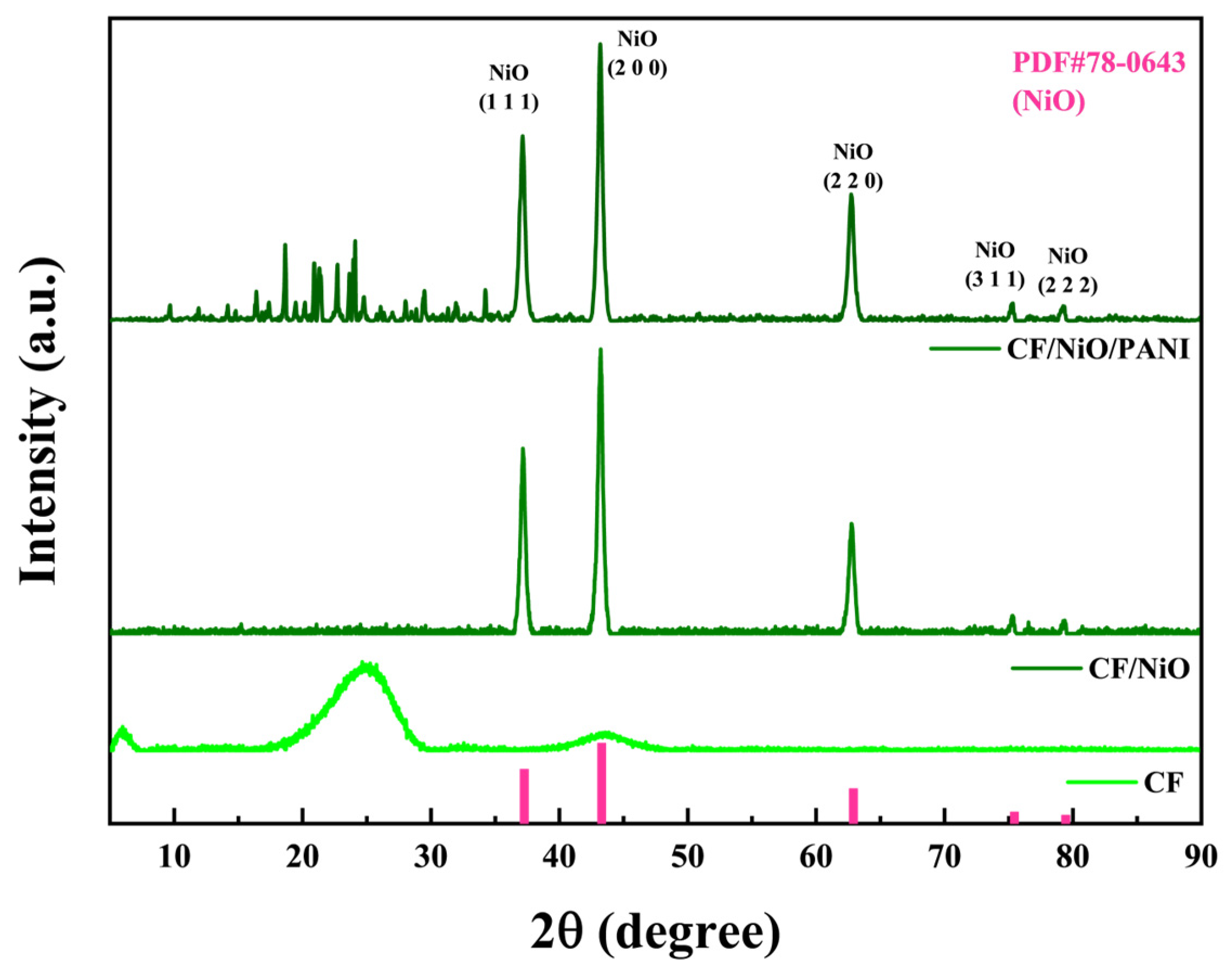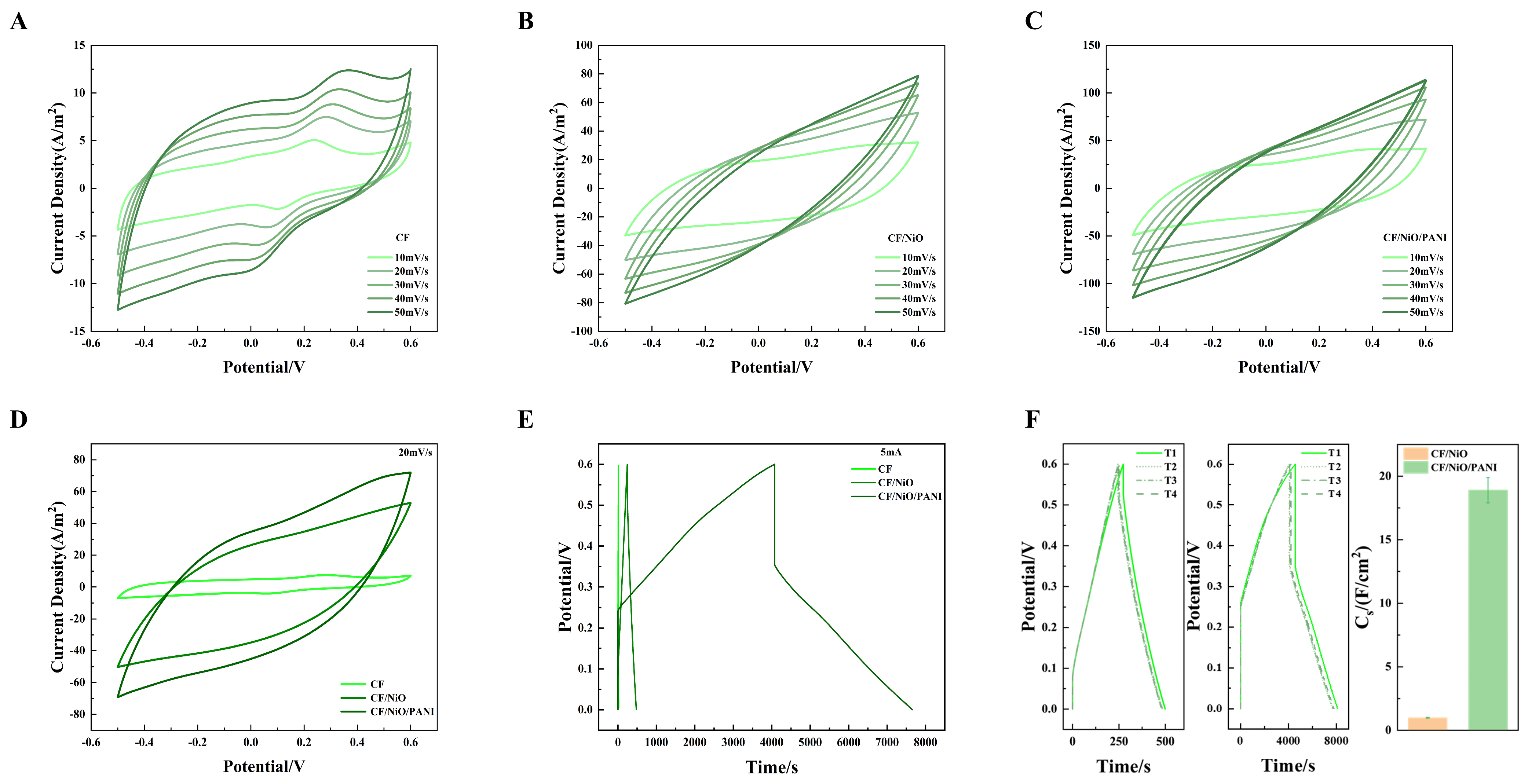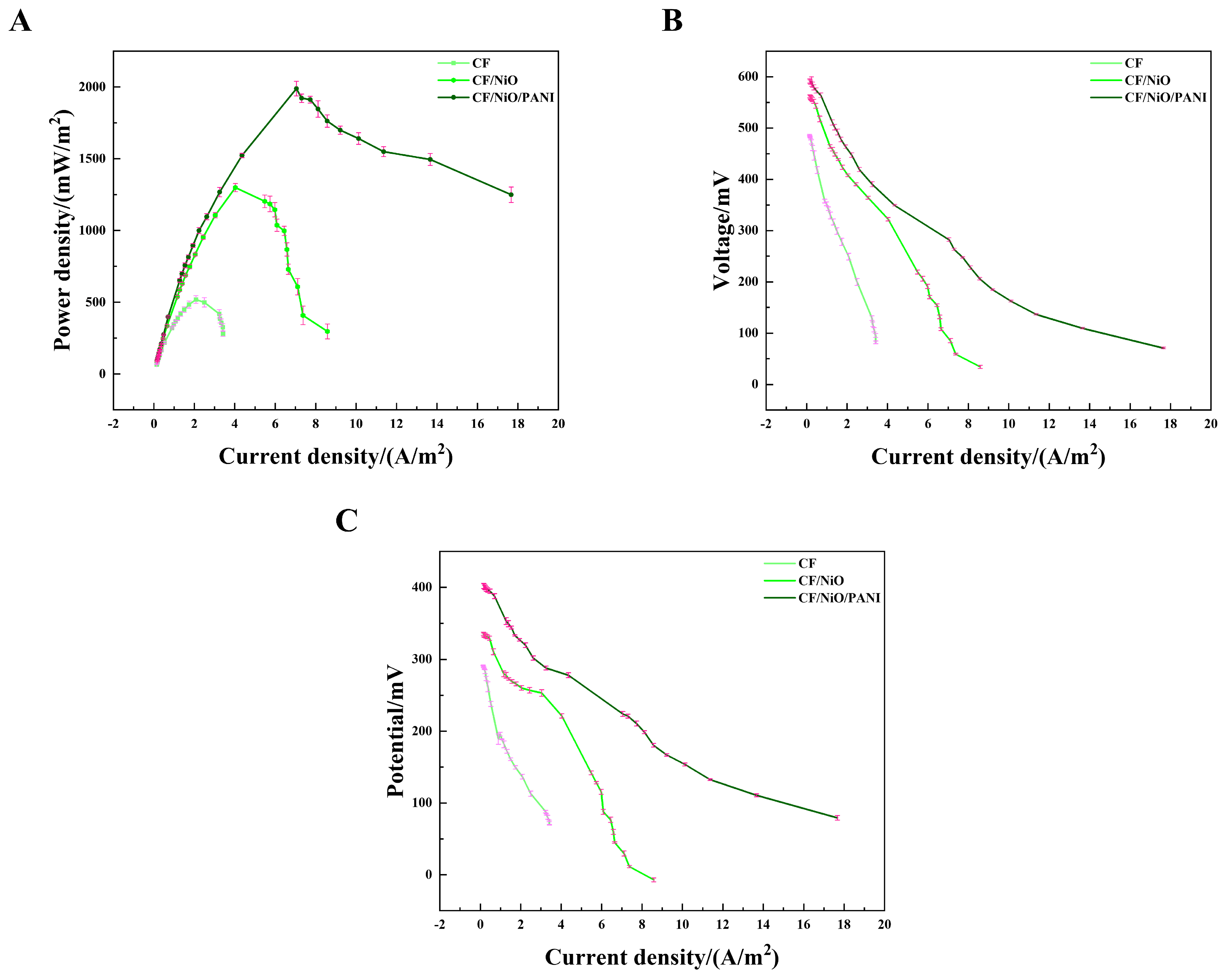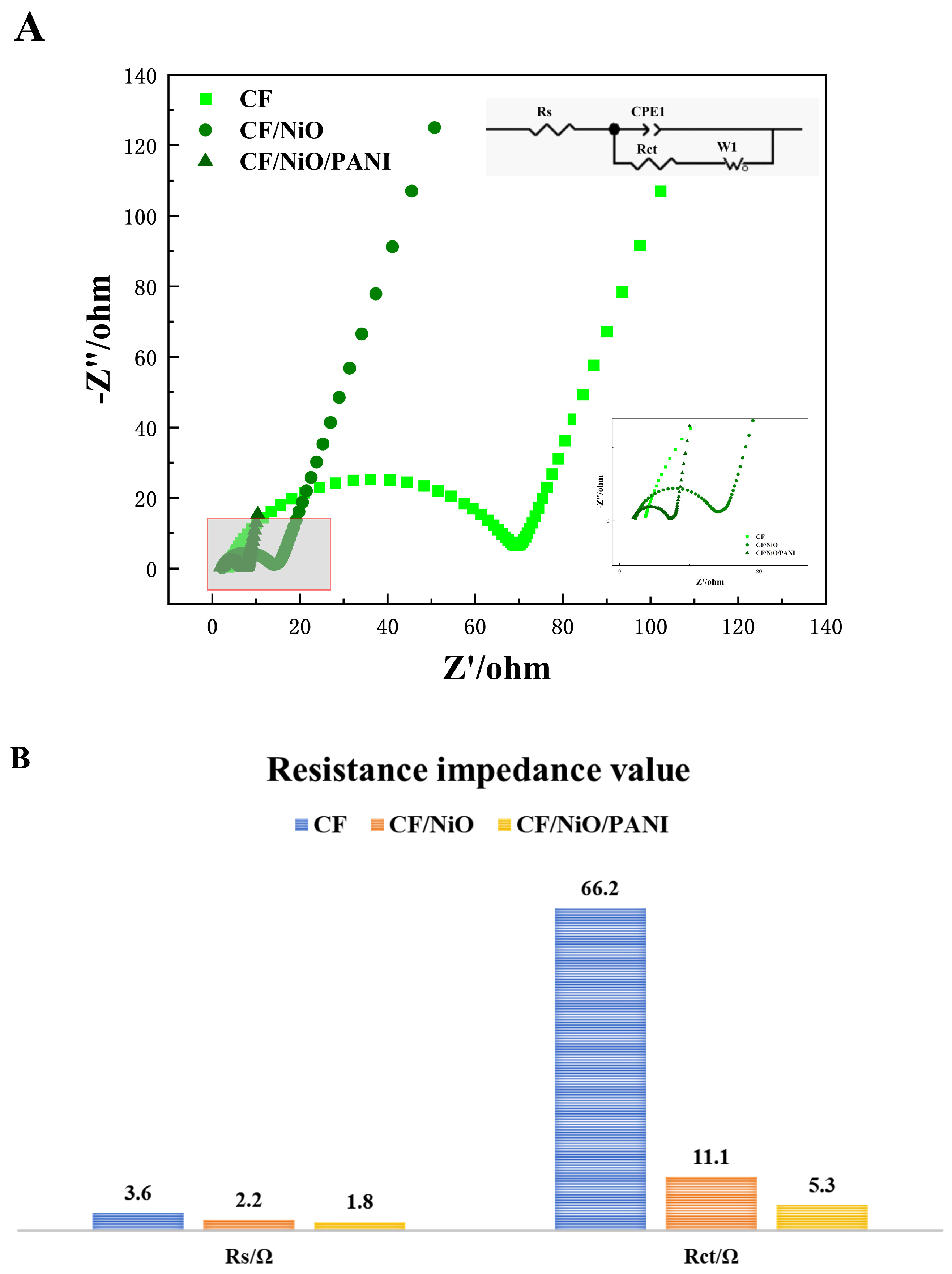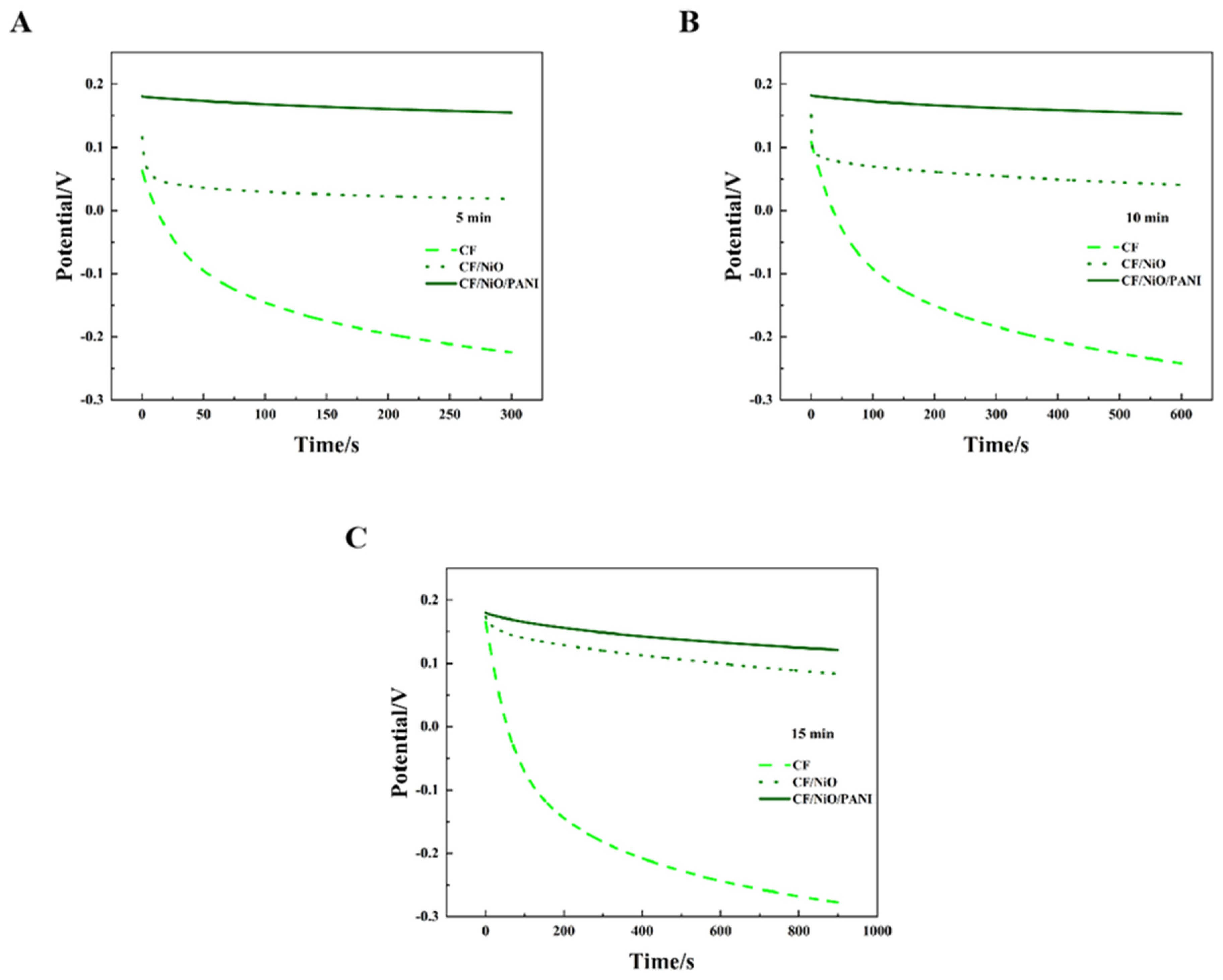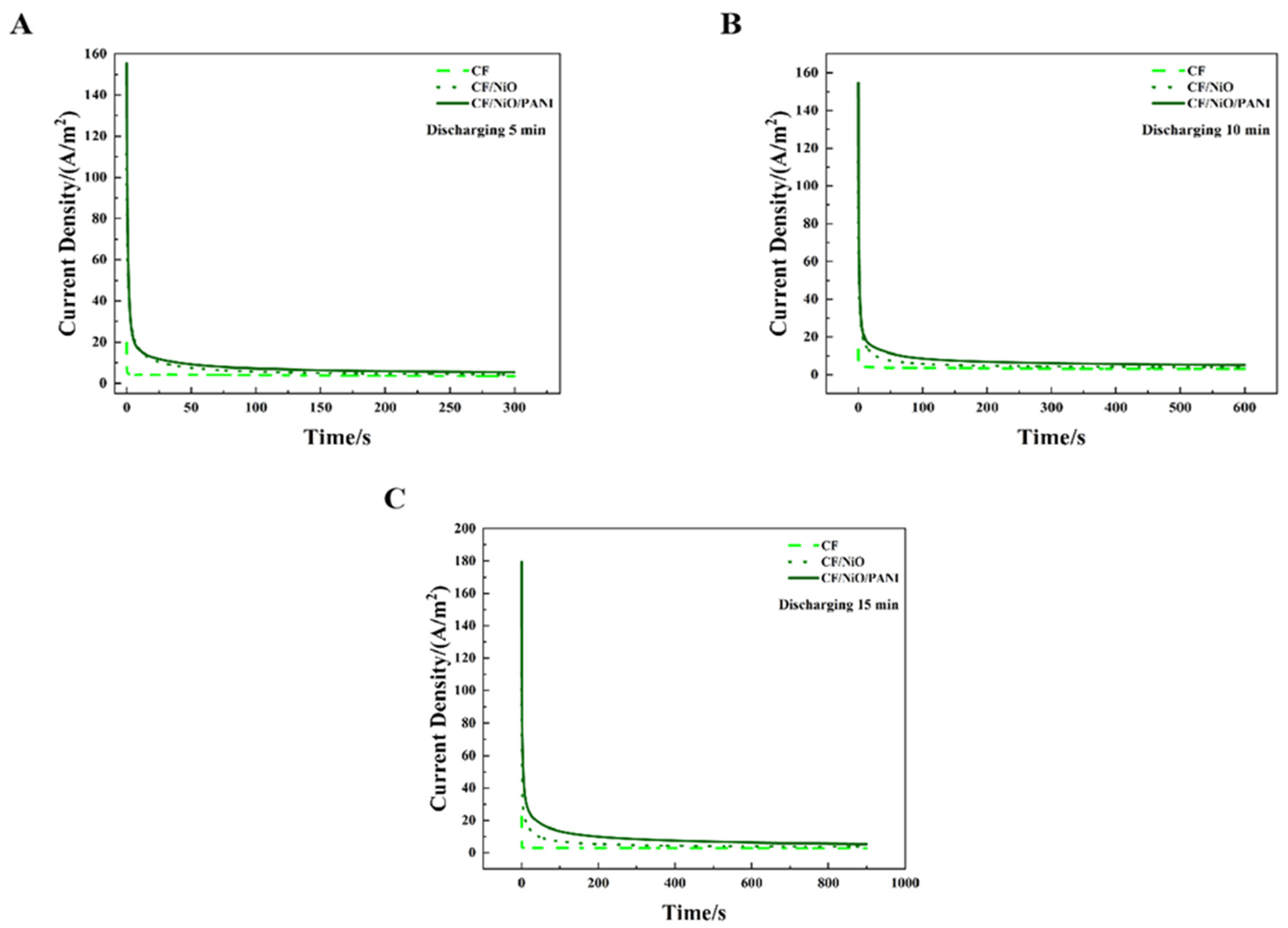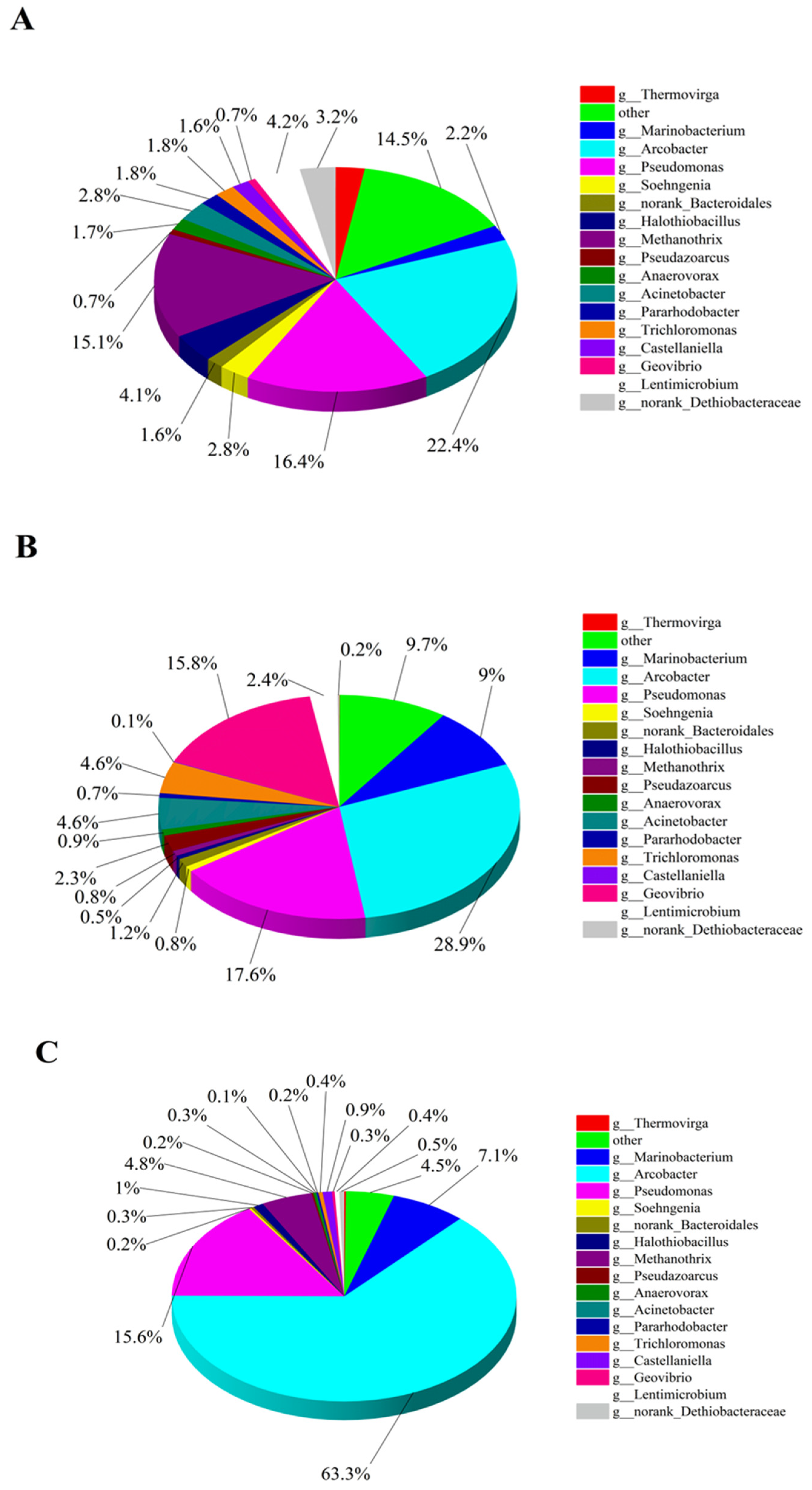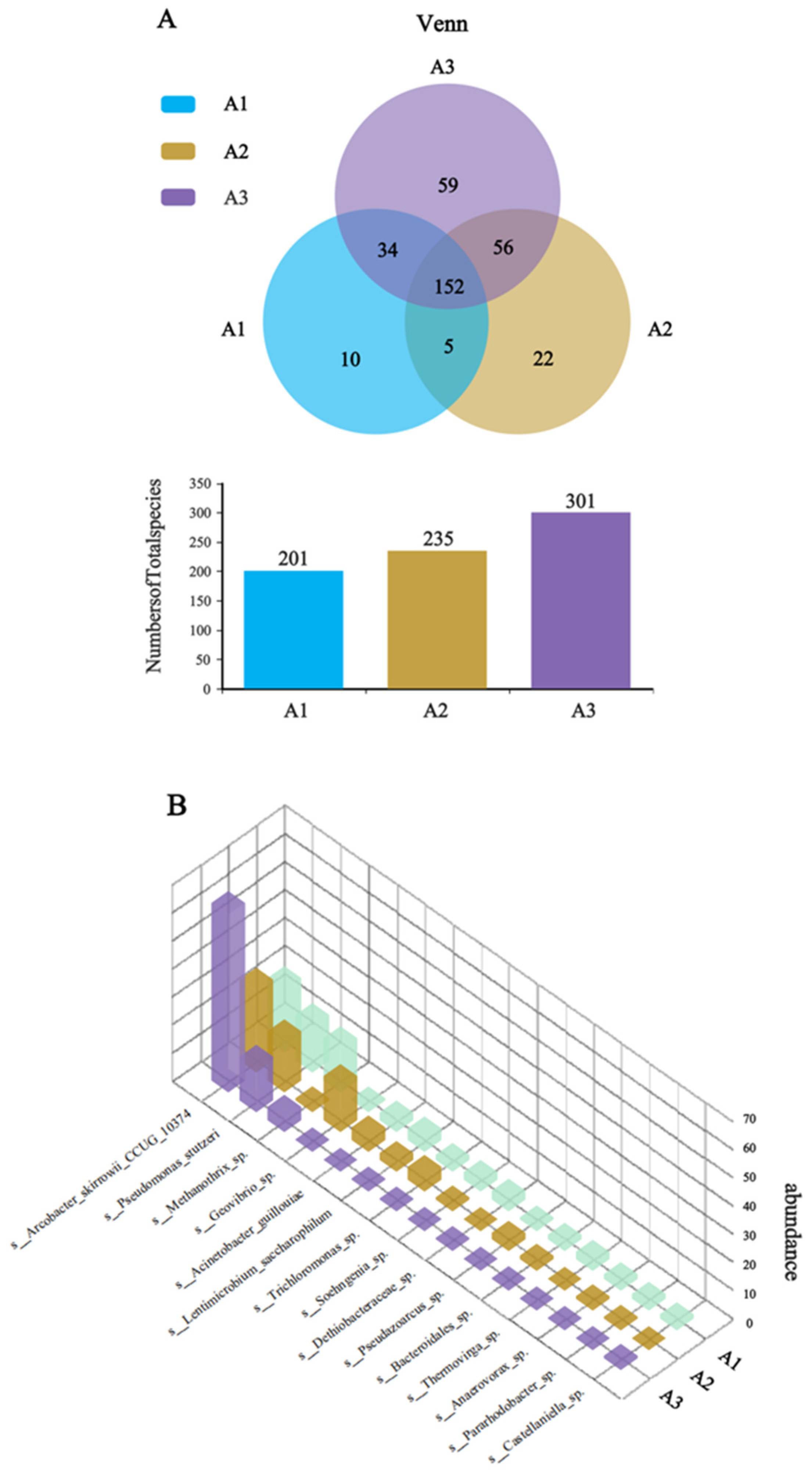3.1. Morphological Characteristics of the Prepared CF/NiO/PANI Electrode
The prepared electrodes were subjected to scanning electron microscope (SEM) testing for the morphological characterization of the electrode fiber surface.
Figure 2A–I show the surface microstructure of CF, CF/NiO, and CF/NiO/PANI electrodes at magnifications of 500×, 2000×, and 10,000×.
Figure 2A–C clearly present the typical structure and smooth surface of the carbon fiber material of CF. By performing acid pickling and water washing treatments on the purchased CF substrate, inorganic impurities and ash on the raw material were removed, improving both the electrical conductivity and the surface characteristics of CF. This makes its surface smoother, which is conducive to the combination with subsequent composite materials.
Figure 2D shows the surface microstructure of the CF/NiO electrode fiber. It can be clearly seen that the prepared NiO is uniformly and tightly loaded onto the pretreated CF fiber. The prepared NiO exhibits a dandelion-like flocculent morphology (
Figure 2F), and its inherent three-dimensional structure significantly increases the specific surface area of the CF fiber. This can provide more active sites for microbial attachment and release more electrons to achieve a higher current density.
Figure 2G shows that after the successful loading of PANI, the carbon fiber becomes noticeably thicker and effectively encapsulates the fiber surface and the NiO metal surface, forming a dense coral-like structure (
Figure 2I). Due to the loading of PANI, the specific surface area has been further increased, and the good biocompatibility of the polymer PANI can promote the formation of a tight biofilm of microorganisms on the surface of the electrode fibers, effectively reducing the limitation of low output power density caused by the limited efficiency of the transmembrane and extracellular electron transfer processes [
26]. A good biofilm can increase the current generation efficiency, enhance stability, and improve the reaction rate in the degradation of organic substances and the electron transfer process, thereby enhancing the overall energy conversion efficiency. By designing a composite material of CF, NiO, and PANI, and combining the advantages of each material, the output power of MFCs can be increased. This enables MFCs to have the functions of simultaneous power generation and energy storage, providing an effective approach for the further development of MFC applications.
The energy dispersive spectroscopy (EDS) image in
Figure 3 shows that the CF electrode after pretreatment is mainly composed of carbon (C) and oxygen (O), with no recognizable impurities (
Figure 3A). The EDS of the CF/NiO electrode, shown in
Figure 3B, indicates that it is primarily composed of carbon (C), oxygen (O), and nickel (Ni), with no recognizable impurities. Additionally, to provide quantitative and spatial distribution information of the elements in the carbon fibers of the CF/NiO electrode, an elemental distribution map was generated (
Figure 3D). The EDS spectrum confirmed the presence of Ni, O, and C, with Ni having an atomic percentage of 55%. The EDS image in
Figure 3C shows that the CF/NiO/PANI electrode fibers are mainly composed of nickel (Ni), oxygen (O), carbon (C), and nitrogen (N). Moreover, the percentage of nitrogen atoms in the CF/NiO/PANI anode reached 19.27%, and this observation indicates that the polymer (PANI) is effectively loaded onto the metal oxide (NiO). The spatial distribution information of each element is shown in
Figure 3E. These elements are uniformly distributed over the entire surface of the CF/NiO/PANI electrode fibers. The uniform distribution of these elements observed in the mapping image verifies that NiO and PANI are successfully integrated onto the carbon substrate fibers. After the low-temperature polymerization process, the polyaniline molecules are interconnected on the surface of CF/NiO through hydrogen bonds, forming a tight and uniform coating. This modification can enhance the intercalation of ions and promote the diffusion of ions or electrons to the boundaries within the electrochemical cell. In addition, the composite structure of CF, NiO, and PANI provides a large effective surface area and high conductivity, ultimately improving the overall performance of the anode. This composite effect promotes sufficient contact between the reactants and facilitates the transfer of electrons and ions.
The FTIR spectra of the prepared electrode materials are shown in
Figure 4A. As shown in
Figure 4A, the CF/NiO composite exhibits characteristic Ni-O vibration peaks at 410.5 cm
−1 (symmetric stretching), 490.5 cm
−1 (asymmetric stretching), and 564.0 cm
−1 (possibly related to surface hydroxyl groups or lattice defects), confirming the successful synthesis of NiO. Additionally, a peak at 1614.5 cm
−1, attributed to the H-O-H bending vibration of adsorbed water, is observed due to the porous CF structure prone to adsorbing moisture. For the CF/NiO/PANI composite, the Ni-O peaks shift to higher wavenumbers (444.3, 499.6, and 574.9 cm
−1; blue-shifted peaks), suggesting coordination between PANI functional groups (-NH- and -N=) and Ni
2+, which redistributes the electron density and strengthens the Ni-O bonds. The reduced intensity of the C-N stretching peak at 1293.0 cm
−1 could be attributed to PANI doping state variations or NiO-induced structural interference [
27]. Peaks at 1541.9 cm
−1 (C=C vibration in PANI quinoid rings) and 1747.8 cm
−1 (oxidized C=O groups) further validate PANI incorporation. A weak peak at 3778.9 cm
−1, assigned to free O-H stretching (e.g., adsorbed water or surface -OH), shows a blue-shifted position compared to the typical hydrogen-bonded O-H region (3200–3600 cm
−1), likely due to steric hindrance from PANI suppressing hydrogen bond formation. These results confirm the successful loading of PANI and its chemical interaction with NiO/CF.
The surface chemical composition and interfacial interactions of carbon felt/nickel oxide (CF/NiO) and its polyaniline composite (CF/NiO/PANI) were comparatively analyzed using X-ray photoelectron spectroscopy (XPS), revealing key differences in chemical state distributions and their implications for electrode performance (in
Figure 4B–F). For CF/NiO, the C 1s spectrum exhibits three characteristic peaks at 284.8 eV (C-C/C-H bonds of the carbon fiber substrate), 286.0 eV (C-O/C-N bonds from surface oxidation or residual CTAB), and 286.8 eV (C=O/O-C=O groups from deep oxidation), indicating a gradient oxidized surface formed during pretreatment and annealing. The O 1s spectrum shows dominant lattice oxygen of NiO (529.1–529.5 eV) and minor oxygen-containing groups (531.2–533.9 eV, attributed to hydroxyl, carboxyl, and adsorbed water). The Ni 2p spectrum confirms the NiO phase (Ni
2+main peak at 854.4 eV) with a trace of surface Ni
3+ (855.9 eV), likely from incomplete reduction during annealing. In contrast, for CF/NiO/PANI, the C 1s spectrum reveals additional peaks at 286.6 eV (C-N bonds in PANI backbone) and 291.3 eV (N-C=O from amide groups), while the O 1s spectrum shows a new peak at 534.1 eV (oxygenated species related to PANI). The N 1s spectrum further validates PANI coating through peaks at 399.2 eV (imine -N=), 399.9 eV (amine -NH-), and 401.8 eV (protonated -NH
+- or Ni-PANI coordination bonds). Notably, the Ni 2p spectrum of CF/NiO/PANI exhibits a shifted peak at 856.7 eV, assigned to Ni
2+ coordinated with PANI nitrogen (-N→Ni), alongside an enhanced Ni
3+ signal at 856.5 eV, attributed to ammonium persulfate-induced oxidation during PANI polymerization. However, the CF/NiO electrode relies on NiO lattice oxygen and surface oxygen functional groups for redox activity, yet its performance is limited by the low conductivity of carbon fibers and instability of surface groups. In contrast, CF/NiO/PANI achieves multifunctional enhancements: (1) the conductive PANI network (-NH
+- doping) improves charge transfer and capacitance; and (2) Ni-PANI coordination (856.7 eV) and Ni
3+/Ni
2+ redox pairs (854.4–856.5 eV) synergistically enhance interfacial charge transfer kinetics. Additionally, the hygroscopic nature of PANI likely contributes to the enhanced hydroxyl adsorption peak at 531.8 eV (O 1s), potentially facilitating ion diffusion at the electrode/electrolyte interface. The above results demonstrate that CF/NiO/PANI exhibits higher specific capacity, rate performance, and stability through chemical bonding and multi-component synergy, providing a basis for high-performance electrode designs aimed at enhancing power and energy storage in microbial fuel cells.
The crystal phase and structure of the experimentally prepared composite materials were characterized using X-ray diffraction (XRD). As shown in
Figure 5, the diffraction peaks of the composite material CF/NiO at 2θ = 37.2°, 43.2°, 62.8°, 75.3°, and 79.4° correspond to the (111), (200), (220), (311), and (222) planes of face-centered cubic NiO (PDF#78-0643). This confirms the successful preparation and loading of NiO, and no significant impurity peaks are observed, indicating the high purity of the prepared material. For CF/NiO/PANI, the NiO peaks (37.1°, 43.2°, 62.8°, 75.3°, 79.2°) remained prominent, demonstrating that PANI deposition does not alter the crystallinity of NiO. Notably, weak diffraction peaks were observed between 10° and 30° in CF/NiO/PANI, which were absent in CF/NiO. These features were attributed to the partial ordering of PANI chains induced by interfacial interactions with NiO, as supported by XPS analysis (e.g., in
Figure 4F, N 1s peak at 401.8 eV for Ni
2⁺-N coordination). Such interactions were found to promote local alignment of PANI chains, generating weak diffraction signals typically associated with π-π stacking (15°–25°). However, the broad and low-intensity features suggested that PANI remained predominantly amorphous, consistent with its low crystallinity in composite systems. These diffraction peaks appear to result from the overlap of NiO peaks and PANI peaks. The peak intensities indicated that the surface-deposited PANI did not significantly affect the crystallization characteristics of NiO [
28,
29,
30]. It is noteworthy that the loading of polyaniline preserved the crystalline structure and pseudocapacitive properties of NiO while enhancing electrode biocompatibility. Strong interfacial interactions were formed among polyaniline, CF, and NiO, leading to significantly improved MFC output power. This configuration achieved dual functionality for simultaneous power generation and energy storage, ultimately enhancing the performance of the MFCs.
3.2. Output Characteristics of MFCs
The cyclic voltammetry (CV) analysis was performed on the prepared CF, CF/NiO, and CF/NiO/PANI electrode samples, with the corresponding data presented in
Figure 6A–D. As shown in
Figure 6A–C, when the scan rate was increased from 10 mV/s to 50 mV/s, the CV curve contour shapes of CF, CF/NiO, and CF/NiO/PANI maintained unchanged shapes with consistent symmetry and stability. It is worth noting that CF/NiO/PANI exhibited a symmetrical rectangular CV curve with a broad oxidation peak, confirming the formation of an electric double layer (EDL) on its surface. The enhancement of capacitance originates from the pseudocapacitive contributions of NiO, the unique pore structure providing more active sites for ions to enter the electrode surface, and the unique electrochemical properties and doping mechanism of PANI. The PANI-NiO composite demonstrated significantly improved capacitive energy storage and structural stability compared to individual components. This hybrid structure reduces energy dissipation through optimized charge transfer pathways, thereby extending the electrode lifespan. For direct comparison, CV data acquired at 20 mV/s within the −0.6 V to 0.5 V potential window were analyzed. As shown in
Figure 6D, both CF/NiO and CF/NiO/PANI exhibited CV curves with substantially larger enclosed areas and improved symmetry compared to pure CF. The larger enclosed area and good CV curve indicate that the electrode has a large specific capacitance and good stability. This observation suggests that the charge transfer resistance in the CF/NiO electrode is low and there is sufficient active surface area for electron transfer. Despite the absence of distinct redox peaks, the quasi-rectangular CV profile of CF/NiO confirms excellent capacitive behavior from NiO modification. It is worth noting that the capacitance of the CF/NiO/PANI anode is significantly higher than that of the CF/NiO and blank CF anodes. This increase in capacitance can be attributed to the modification by pseudocapacitive materials such as metal oxides and polymers. Although no redox peaks were observed, symmetrical oxidation and reduction processes occurred at almost the same rate. This finding indicates that the charge–discharge process of the CF/NiO/PANI anode is relatively reversible. The larger pore size on the anode surface facilitates the rapid transfer of ions in the electrolyte (with low diffusion resistance) both inside and outside the electrode. Furthermore, minimized contact resistance ensures efficient charge transfer, accelerating redox kinetics and thereby boosting pseudocapacitive performance.
Figure 6E shows the CP curves obtained by potentiostatic analysis of blank CF, CF/NiO, and CF/NiO/PANI anodes. It can be clearly seen from
Figure 6E that the discharge time (3592s) of the CF/NiO/PANI electrode is significantly longer than that of the blank CF electrode and the CF/NiO electrode (479s). The significant increase in the charging/discharging time indicates that a more excellent specific capacitance performance is achieved after modification with the composite of NiO and PANI. The specific capacitance (
) is calculated using Formula (2). The specific capacitance (
) was calculated using the following equation:
where
indicates the specific capacitance (mF/cm
2) of the MFC device;
denotes the curve integral area (V·s);
refers to the current density (A/cm
2) of the fabricated electrode; and
and
represent the initial potential (V) and the terminal voltage (V) of the external resistor in the MFC device, respectively.
The
value of the CF/NiO electrode is 0.98 ± 0.04 F/cm
2. This indicates that, at the same current density (1.25 mA/cm
2), its capacitance performance is 24.5 times higher than that of the blank CF electrode (0.04 F/cm
2). The
value of the CF/NiO/PANI electrode is 18.91 F/cm
2. At the same current density, its capacitance performance is 472.8 times higher than that of the blank CF electrode (0.04 F/cm
2) and 19.3 times higher than that of the CF/NiO electrode (0.98 ± 0.04 F/cm
2). When the current density is 1.25 mA/cm
2, the chronopotentiometry (CP) curve of CF/NiO resembles the shape of an isosceles triangle (
Figure 6E). This observation is highly consistent with the typical high capacitance performance of a double-layer capacitor. Meanwhile, the repetitive data from multiple independent experiments (
Figure 6F) indicate the stability of the electrode and the feasibility of the experimental method. In addition, the combination of NiO and PANI is conducive to promoting a good ion diffusion rate, enabling the electrode to have an excellent energy storage capacity as well as superior cycling performance. It is precisely due to the enhanced charge storage performance of NiO and the efficient reversible redox reaction pseudocapacitance characteristics of PANI, along with its good conductivity and biocompatibility, that the CF/NiO/PANI electrode is expected to enhance the power generation capacity and charge storage performance of MFCs.
To evaluate the power output, the MFC device was constructed in a two-chamber container (
Figure S1). Initially, the output voltage of the MFC increased continuously with time. Within approximately 3 days, it reached a relatively stable state, indicating the successful construction of the MFC. Once the output voltage stabilized, the 8000 Ω resistor used during the initial phase was disconnected, and an external sliding rheostat was connected between the cathode and the anode. The load resistance values in the circuit were varied to obtain the corresponding voltage values. The power density curve, current–voltage (I–V) curve, and anode polarization curve were obtained through calculation. The power density curve (
Figure 7A) shows that the maximum power densities of the three electrodes have significant differences. The maximum power density of the blank CF electrode was measured to be 518.29 ± 27.07 mW/m
2 by averaging multiple measurements. However, the average maximum power density of the CF/NiO/PANI electrode reached 1988.31 ± 50.96 mW/m
2, which is much higher than that of the CF/NiO electrode (1298.84 ± 28.32 mW/m
2) and the blank CF (518.29 ± 27.07 mW/m
2). The maximum power density achieved by the CF/NiO/PANI electrode is significantly higher than that of other electrode materials previously reported (
Table 1). Additionally,
Figure 7B shows that the open circuit voltages of the CF/NiO and CF/NiO/PANI electrodes are similar at approximately 0.6 V, which is consistent with the maximum voltage output of similar MFCs. It was noted that the CF/NiO/PANI electrode displayed the maximum average current output of 17.67 ± 0.38 A/m
2, which was significantly higher than that of the blank CF (3.42 ± 0.11 A/m
2) and CF/NiO (8.58 ± 0.76 A/m
2). It was proven that a large number of microorganisms effectively transformed organic matter and released electrons, achieving relatively high current density and stability. Moreover, the anode polarization curve (
Figure 7C) provided further evidence supporting the excellent electrochemical performance of the composite bioanode. In
Figure 7C, the polarization curve of the CF/NiO/PANI anode was the most gradual, indicating high electrochemical reaction activity and efficient electron transfer between the anode and microorganisms, while the polarization curve of the blank CF anode showed the most drastic change, suggesting limited reaction activity.
Among these three electrodes, the CF/NiO/PANI capacitive bioanode exhibits greater power density and superior polarization performance. The innovative multilayer structure significantly enhances the availability of active sites on the electrode and shortens the ion diffusion path, thereby forming a more direct conduction path [
31,
32,
33,
34]. The incorporation of NiO enhances both the power output performance and pseudocapacitance of the electrode, while the increased specific surface area promotes higher loading of PANI. The addition of PANI facilitates charge transfer due to its excellent biocompatibility and promotes the growth of electrogenic bacteria, which further enhances the energy storage performance of the electrode. Therefore, the increase in current density can be attributed to either a higher bacterial load in the anode biofilm or more efficient charge transfer with reduced charge loss due to the enhanced charge transfer rate. Additionally, the synergistic effect of incorporating NiO and PANI, along with the increased specific surface area, improved electrochemical properties, better conductivity, and enhanced quasi-Faraday effect, collectively contribute to the MFC exhibiting higher output power and superior polarization performance.
Table 1.
The power densities of MFCs modified with polymers and metal oxides on the anode documented in the literature.
Table 1.
The power densities of MFCs modified with polymers and metal oxides on the anode documented in the literature.
| | References | Anode | Power Density |
|---|
| 1 | This study | CF/NiO | 1298 ± 28 mW/m2 |
| 2 | This study | CF/NiO/PANI | 1988 ± 51 mW/m2 |
| 3 | Park et al. [15] | CP/CNT/Fe3O4 | 830 mW/m2 |
| 4 | Wang et al. [19] | CF/MnO2 | 872.0 mW/m2 |
| 5 | Wang et al. [19] | CF/MnO2/PANI/MnO2 | 1124.8 mW/m2 |
| 6 | Kumar et al. [35] | NiO/RGO | 71.1 mW/m2 |
| 7 | Peng et al. [36] | AC/SSM | 664 ± 17 mW/m2 |
| 8 | Peng et al. [36] | AC/Fe3O4/SSM | 809 ± 5 mW/m2 |
| 9 | Mishra et al. [37] | CC/MWCNT-MnO2/PPy | 1125.4 mW/m2 |
| 10 | Mehdinia et al. [38] | MWCNT/SnO2/GC | 1421 mW/m2 |
| 11 | Feng et al. [39] | CF/AQDS/PPy | 1300 mW/m2 |
In order to study the reasons for the performance improvement of MFCs and evaluate the charge transfer efficiency through the electrolyte/electrode interface, electrochemical impedance spectroscopy (EIS) tests were conducted in the frequency range of 0.01 Hz to 100 kHz. The semicircle at high frequencies corresponds to part of the electron transfer process, while the linear portion at low frequencies indicates good capacitive behavior due to rapid electron transfer. The internal circuit diagram represents the equivalent fitting circuit used to analyze the corresponding EIS data. This circuit includes electrolyte resistance (Rs), double-layer capacitance (Cdl), charge transfer resistance (Rct), and the Warburg element (Rw). Rs encompasses solution resistance, electrode internal resistance, contact resistance, and electrolyte ion resistance within the system [
40]. It can be directly read from
Figure 8B that the Rs value of the CF/NiO/PANI electrode is 1.8 Ω, which is significantly lower than that of the blank CF electrode (3.6 Ω) and the CF/NiO electrode (2.2 Ω). This suggests that the conductivity between the electrolyte solution and the prepared composite electrode material CF/NiO/PANI has been enhanced. These results indicate that the CF/NiO/PANI electrode structure facilitates the rapid migration of electrolyte ions and the efficient transfer of electrons into the material. The Rct values of the CF electrode, the CF/NiO electrode, and the CF/NiO/PANI electrode are 66.2 Ω, 11.1 Ω, and 5.3 Ω, respectively. Both the Rs and Rct values of the CF/NiO/PANI electrode are much lower than those of the blank CF electrode, indicating a significant improvement in the rate of electron transfer from bacteria to the electrode. This improvement is mainly attributed to the increase in the anode’s specific surface area, the nanostructured network formed by polyaniline that promotes the electron conduction path, and NiO that enhances the ability of direct electrochemical interaction between bacterial cells and the electrode, which jointly enhance the charge transfer efficiency of the entire system. However, in the low-frequency range of
Figure 8A, the slope of the linear part is related to the magnitude of the Warburg resistance (Rw), and the magnitude of Rw is attributed to the diffusion of electrolyte ions within the electrode pores. Moreover, a lower slope of the straight line indicates a higher Rw. As observed from the figure, in the low-frequency range, the slope of the straight line decreases successively from the CF/NiO/PANI electrode to the CF/NiO electrode, and then to the blank CF electrode. Therefore, the Warburg resistance (Rw) increases in this order, and the ion diffusion rate also gradually slows down. Among these three electrodes, the electrochemical performance of the CF/NiO/PANI electrode is the best. The above results indicate that the enhanced conductivity of polyaniline and the improved catalytic performance of nickel oxide contribute to the increased electrochemical activity and reaction kinetics of the electrode. The structural optimization of the composite material increases the current transmission capacity and contact area while maintaining good mechanical strength and stability, thereby effectively reducing the overall impedance of the electrode.
3.3. Storage Capacity of MFCs
Figure 9A–C show the open circuit potential–time profiles of MFCs with electrodes CF, CF/NiO, and CF/NiO/PANI when an external 200 Ω resistor is connected during charging periods of 5 min, 10 min, and 15 min, respectively. It is worth noting that the potentials of the three anodes all exhibited a similar downward trend in the open circuit potential–time curves at 5 min, 10 min, and 15 min. However, distinct differences in decay rates were observed among the anodes in each dataset. Among them, the blank CF anode has the most pronounced decline, followed by the CF/NiO anode, while the CF/NiO/PANI anode exhibits the weakest downward trend. In
Figure 9C, the blank CF anode potential plummeted from 0.166 V to −0.278 V. In contrast, the potential change of the CF/NiO anode was relatively slow, dropping from an initial potential of 0.174 V to 0.083 V over a period of 15 min. Compared with the blank CF anode, this electrode exhibited a higher initial potential. This behavior suggests that NiO’s high electrochemical activity enhanced oxidation kinetics, while its uniform coating (
Figure 8B) reduced charge transfer resistance. These combined effects enabled the CF/NiO anode to maintain a higher initial potential with suppressed current loss, thereby prolonging potential retention. Additionally and most significantly, the initial potential of the CF/NiO/PANI anode dropped from 0.180 V to 0.121 V after 15 min. This 0.059 V decay was significantly smaller than the 0.444 V and 0.091 V losses observed for the blank CF and CF/NiO anodes, respectively. The incorporation of NiO provided a larger specific surface area for CF fibers, promoting the loading of PANI. Meanwhile, the pseudocapacitance characteristics of NiO and PANI, as pseudocapacitive materials, facilitated rapid N-type or P-type doping and dedoping redox reactions, ultimately leading to the enhancement of Faradaic capacitance. Therefore, the CF/NiO/PANI composite electrode stored more charges compared to the CF/NiO electrode and the blank CF electrode, achieved a higher initial potential, and exhibit better electrical conductivity and environmental stability, thereby enhancing the energy storage capacity of MFCs and slowing down the decrease in anode potential.
Figure 10 shows the MFC discharge curves of the three electrodes under an external resistor (200 Ω) condition at charge–discharge cycle periods of 5 min, 10 min, and 15 min. It can be seen from
Figure 10A–C that the discharge curves of these three electrodes all exhibit a peak current density, after which the current density decreases over time and eventually reaches a relatively stable state. Based on the existing data,
Table 2 can be obtained through calculation and visually presents the peak current density (i
h), steady-state current density (i
s), charge storage capacity (Q
s), and total charge quantity (Q
t) of the three electrodes across different charge–discharge cycle periods. It can be seen from
Table 2 that in the 15 min charge–discharge cycle, the peak current density (i
h) of the MFC with the CF/NiO/PANI electrode reached 179.40 A/m
2, which was much higher than that of the MFC with the blank CF electrode (20.00 A/m
2) and the MFC with the CF/NiO electrode (110.43 A/m
2). Meanwhile, the steady-state current density (i
s) of the MFC with the CF/NiO/PANI electrode reached 5.41 A/m
2, which was much higher than that of the MFC with the blank CF electrode (3.60 A/m
2) and the MFC with the CF/NiO electrode (3.86 A/m
2). It is worth noting that the total charge (Q
t) and stored charge (Q
s) of the CF/NiO/PANI electrode reached 8175.89 C/m
2 and 3304.64 C/m
2, respectively, which were significantly higher than those of the blank CF electrode (Q
t = 4860.50 C/m
2, Q
s = 1386.50 C/m
2) and the CF/NiO electrode (Q
t = 3552.50 C/m
2, Q
s = 314.75 C/m
2). The total charge (Q
t) and stored charge (Q
s) of the CF/NiO/PANI electrode were 1.74 times and 2.38 times those of the blank CF electrode, and 2.30 times and 10.44 times those of the CF/NiO electrode, respectively. Similarly, the results of the charge–discharge tests conducted at 5 min and 10 min were consistent with the trend observed in the 15 min charge–discharge tests.
The chronoamperometry test (CA) results show that among these three electrodes, the MFC equipped with the CF/NiO/PANI electrode not only has the highest peak current and steady-state current but also exhibits the largest total charge and stored charge, reaching 2.30 times and 10.50 times that of the blank CF electrode, respectively. This significant enhancement indicated that NiO modification (CF/NiO) endowed the electrode with excellent energy storage capability and high power output. Uniform NiO deposition on carbon fibers (
Figure 2D) increased the specific surface area, facilitating microbial attachment/growth/colonization, providing abundant active sites, and enhancing electrochemical activity. As an efficient catalyst, NiO promoted electrochemical reactions, accelerated kinetics, boosted current density, and enabled higher current output at identical potentials. Additionally, the introduction of NiO improved the double-layer capacitance characteristics of the electrode and enhanced the capacitance performance, resulting in a higher total charge and charge storage capacity under good electrical conductivity. Notably, the increased surface area after loading NiO allows carbon fibers to load more PANI. PANI, as a conductive polymer, significantly improves the conductivity of the electrode and enhances the charge transfer efficiency when combined with CF and NiO. Both PANI and nickel oxide exhibit good electrochemical catalytic effects, accelerated the electrochemical reaction kinetics, thereby accelerated current density. Furthermore, their combination can generate a synergistic interaction between them, providing more active sites for the electrochemical reactions in microbial fuel cells. The expanded surface area enhanced reactant accessibility to active sites, while the composite EDL effect improved both reaction rates and capacitive energy storage. Simultaneously, the optimized surface properties of the composite promoted microbial adhesion, strengthening microbe–electrode interactions and boosting energy conversion efficiency. Simultaneously, the optimized surface properties of the composite promoted microbial adhesion, strengthening microbe–electrode interactions and boosting energy conversion efficiency. During power shortages, the MFC stored microbially generated energy within its capacitive anode. When power output is required, the MFC can release a higher current, including both the newly generated current and the previously stored current, thereby increasing the overall output power of the device.
3.4. Analysis of Anode Biodiversity and Microbial Community Structure
The basic principle of MFCs is to convert the chemical energy in the substrate into electrical energy using the metabolic processes of microorganisms. The selection of electroactive bacteria has a decisive influence on the performance of MFCs, as different types of microorganisms can significantly alter the current density, energy efficiency, and voltage output. In addition, microorganisms can efficiently decompose complex organic substances into simple and available compounds through the action of metabolic enzymes, thereby maximizing the available energy of the battery. Therefore, microorganisms play a core role in MFCs and directly determine the performance, efficiency, and operational stability of the battery. In this study, we conducted high-throughput sequencing analysis on the surfaces of blank carbon fiber (CF) anodes and modified anodes to explore the microbial community structure and the distribution of electrogenic bacteria. This study aims to deeply explore the key factors that contribute to improving the power generation and energy storage performance of MFCs.
In this high-throughput test, the blank CF anode was used as the control group and labeled as A1, while the CF/NiO anode and the CF/NiO/PANI anode in the experimental groups were labeled as A2 and A3, respectively.
Figure 11A–C show the pie charts of the microbial community composition structure on the anode surface at the genus level for the three anodes. It can be seen from
Figure 11A that the microbial community on the surface of the blank CF anode was primarily composed of Arcobacter (22.3%), Pseudomonas (16.3%), Methanothrix (15.1%), Lentimicrobium (4.1%), and Acinetobacter (2.8%), among others. Among them, the main electrogenic bacteria such as Arcobacter, Pseudomonas, and Acinetobacter account for approximately 41.5%. Methanothrix is a non-electrogenic bacterium. In the MFC system, such bacteria only consume the organic matter in the anode chamber and cannot provide electrical energy for the system. It is regarded as a non-beneficial bacterium in the research on MFC electricity generation. In
Figure 11B, the microbial community on the surface of the CF/NiO anode is mainly composed of Arcobacter (28.9%), Pseudomonas (17.6%), Geovibrio (15.7%), Marinobacter (9.0%), and Trichloromonas (4.6%). The proportion of the main electrogenic bacteria has reached 65.7%, which is significantly higher compared with the blank CF anode. This observation indicates that the loading of NiO provides more suitable environmental conditions for the attachment and metabolism of electrogenic bacteria. The microbial community on the surface of the CF/NiO/PANI anode was mainly composed of Arcobacter (63.3%), Pseudomonas (15.6%), Methanothrix (4.8%), and Marinobacterium (7.1%). Notably, the proportion of the main electrogenic bacteria reached 79.2%, which was significantly higher than that of the blank CF anode (41.5%), with the proportion of Arcobacter increasing from 22.3% to 63.3%. The results indicated that in the limited organic matter environment in the anode chamber, more organic matter was utilized by the electrogenic bacteria, reducing the metabolic consumption of non-beneficial bacteria, thereby increasing charge generation and enhancing electricity production. This can be attributed to the addition of NiO and PANI, which effectively increased the electrogenic bacterial community in the MFC, enhancing its overall performance by improving conductivity, promoting microbial attachment and growth, and enhancing electrochemical reactions. This finding is consistent with the measured power test results.
To investigate the enhanced electrochemical performance of the CF/NiO/PANI bioanode, species-level Venn analysis was performed on the microbial communities of the anode surfaces of the three electrodes. The blank CF anode served as control (A1), with CF/NiO and CF/NiO/PANI designated as A2 and A3, respectively. The Venn diagram (
Figure 12A) revealed distinct microbial diversity patterns among the three anodes. The analysis identified 338 species of microorganisms across the three electrodes, with a total of 152 unique species. Notably, the microbial community of the CF/NiO/PANI anode comprised 301 species, including 59 unique species, which was higher than that of the blank CF anode (201 species, 10 unique species) and the CF/NiO anode (235 species, 22 unique species). The results demonstrate that there are significant differences in the dominant species between the multilayer capacitive biological anode modified with NiO and PANI composite material and the blank CF anode, and the data in
Figure 11 also support this observation. The 3D species abundance histogram (
Figure 12B) further visualizes the dominant microbial populations within the anode chamber microenvironment. The dominant species in A3 include electrogenic bacterial communities such as Arcobacter and Pseudomonas, which account for 78.9%. This percentage is higher than the total abundance of the dominant species Arcobacter, Pseudomonas, and Geovibrio in the electrogenic community of A2 (61.2%) and higher than the total abundance of the dominant species Arcobacter, Pseudomonas, Geovibrio, and Acinetobacter in the electrogenic community of A1 (42.2%). Compared with the CF anode, the CF/NiO/PANI anode shows higher total biomass, richer microbial diversity, and increased aggregation of electrogenic bacteria. These findings confirm that the CF/NiO/PANI bioanode combines exceptional biocompatibility with superior power density (1988.31 ± 50.96 mW/m
2).
